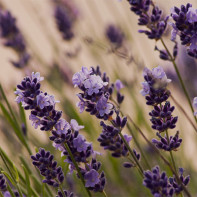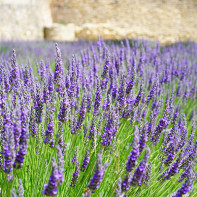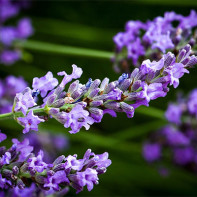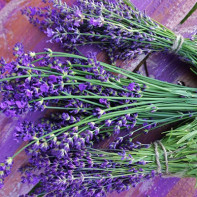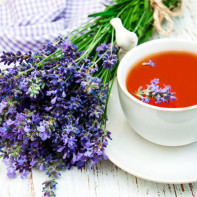Lavender: medicinal properties and contraindications
As soon as someone says the word “lavender”, emotions flare up in the brain of everyone who hears it. One of them has memories of an old grandmother’s dresser, in the corner of which lies a sachet with this marvelously smelling grass. At another, a blue-violet plantation endlessly looking into the distance, seen somewhere in a book, or even personally, on a journey, arises before one’s eyes. And the third just begins to hum: "Lava-a-nda, mountain lava-a-nda ...". This plant is truly legendary.
- Chemical composition
- How it looks and where it grows
- Kinds
- Collection and storage
- What is the difference between sage and lavender
- The healing properties of lavender
- For women
- For men
- During pregnancy
- When breastfeeding
- For kids
- When losing weight
- Lavender in folk medicine
- Types of medicinal compounds with lavender
- Infusion
- Tincture
- Decoction
- Tea
- Ointment
- Syrup
- Lavender oil: properties and applications
- Application in cosmetology
- For neck rejuvenation
- For firm skin
- For strong nails
- For gentle hands and healthy nails
- For facial skin
- Wrinkle Facial Mask
- Acne mask
- For dandruff
- Hair Growth Mask
- Lotion
- Lavender in cooking
- Lavender sugar
- Lavender vinegar
- Lavender lemonade
- Lavender Chicken
- The use of lavender in everyday life
- How to grow lavender at home
- What is lavender honey good for?
- Contraindications
Chemical composition
The pleasant recognizable smell of lavender is due to the essential oil, which is found in all parts of the plant, but most of all in inflorescences - up to 5%. For the most part, it is because of the oil that lavender is valued, for the production of which it is grown. Lavender essential oil is a complex complex of derivatives of various acids, which, not only in combination but also individually, are substances useful to the human body.
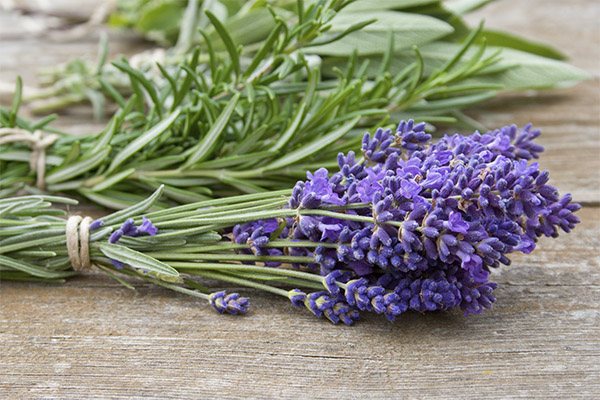
So, ursolic acid, which is part of it, can provide an increase in muscle volume, control metabolism and the amount of blood sugar, and fight excess weight. In addition, this component of lavender inhibits the growth of malignant cells.
Valerianic acid is responsible for the work of the heart, caproic acid plays an anti-inflammatory and hemostatic role. An antiseptic and expectorant effect is characteristic of cineole - a substance with a camphor odor. As an antiseptic and anti-inflammatory agent, citral works, it also has the ability to lower blood pressure. Present in lavender oil and tannin - a well-known tannin, has long been used by medicine as antidiarrheal and antihemorrhoidal weapons.
In addition, lavender contains a whole complex of aromatic substances used in perfumery industries - geraniol, borneol, coumarin, garnierite, amyl alcohol, and lavenderulol.
How it looks and where it grows
Botanists attribute lavender to shrubs - that is, plants whose stem is lignified at the bottom and grassy at the top. In height, this perennial evergreen plant usually grows from 50 to 70 cm, sometimes reaches 80 cm. Its characteristic feature is strong branching, from 700 to 800 shoots can grow on an adult plant, as a result of which the bush becomes spreading, fluffy and attractive, for which gardeners also loved him.
From a distance, the young shoots of lavender look bluish-gray, because its long, small, lanceolate leaves, wrapped down at the edges, are covered with tiny hairs that give them such a color. Older leaflets take on a more saturated green color, but they still have pubescence - at the bottom of the leaf. The leaves can be with notches along the edges, or even, and they sit on the stem in pairs - against each other.
But when the plant blooms - and this begins in June and lasts until August - the leaves become invisible.The bush itself acquires a bewitching blue or bluish-violet color due to numerous flowers collected in narrow tetrahedral inflorescences in the form of a long narrow spike. There is lavender in white, pink and purple, but these are mainly bred varieties, its natural color is still in blue tones.
Each individual flower is small, not more than 1 cm, has a two-lip shape. Fading, it turns into a small fruit, consisting of four small nuts of brown-brown color. Seeds usually ripen by September.
The root of lavender is powerful, lignified, it can go into the soil to a depth much more than a meter.
The natural habitat of lavender is the southern regions of Europe, the Mediterranean coast, the Canary Islands, the northeastern regions of Africa, India, Australia, and the Arabian Peninsula. In Russia, this fragrant plant was chosen by the Caucasus, or rather, its Black Sea coast. Lavender prefers to settle in mountainous areas, and thanks to its long root it is able to extract water in dry places.
Despite the southern origin of the plant, gardeners in the more northern regions adapted to grow it in their plots: someone in the open ground, learning how to create suitable conditions in the winter, someone like a pot culture, planting in the country only in the warm season.
As a culture of economic importance, lavender is grown by whole plantations in southern Europe - Italy, France, Spain.
Kinds
Today, about 50 varieties of lavender are known, united in 6 main groups. At the same time, 4 groups are used for perfumery or medicinal purposes.
The most widespread species is narrow-leaved lavender. For medicinal and perfumery purposes, its inflorescences are used. It comes from the Western Mediterranean, and there this plant can be seen high in the mountains - up to 1,500 meters above sea level.
Broadleaf lavender is a resident of the Balkan Peninsula, Italy, Spain and France. She did not learn how to climb so high into the mountains as her narrow-leaved relative. It has two characteristic features: not only the stems branch, but also the flower stalks, and there are notes of camphor in the smell of leaves.
Intermediate lavender was formed as a result of natural crossing of narrow-leaved and broadleaf. And from it you can get the essential oil twice as much. This feature was noted by people, and by artificial crossing they created varieties that are now grown on an industrial scale to produce oil. True, this oil has retained the shade of camphor odor, and therefore its cost is half that of a product from narrow-leaved lavender. It is used mainly in everyday life.
The name of woolly lavender speaks for itself: its leaves are distinguished by a particularly thick cover of hairs. She is very afraid of moisture and rain and dies at the slightest waterlogging of the soil.
French lavender is distinguished by inflorescences of a dark purple color, quite loyal to moisture, therefore it is suitable for growing somewhere in a lowland.
Collection and storage
Lavender begins to be stored when more than half of the flowers bloom, since this is the period in the life of the plant when it has accumulated the maximum amount of essential oils. Guessing this time is easy - the color and aroma become the most powerful. As a rule, this is the period from mid-June to the end of July.
For decorative purposes - that is, for winter dry bouquets - it is necessary to cut lavender a little earlier, at the bud stage, while essential oils are still not enough. Then their smell will not be too strong and unbearable. At the same stage, lavender is torn and for use in cooking.
Like any other medicinal plant, lavender is harvested in dry weather, and the necessary condition is that it does not rain for 2-3 days. The best time of the day for this is morning, after the dew has dried. No need to wait until midday heat, as then the essential oils from the plant begin to disappear.
The upper part of the stem with a peduncle is cut off with a sharp secateurs or scissors - about 20 cm. It is not worth breaking off the branches with your hands - you can damage the plant.
Then the chopped raw materials in the form of bouquets are hung under the ceiling of the veranda, in the attic, where a draft walks, or in a hay shed, where sunlight and moisture do not reach them. If there are few inflorescences, you can not hang them, but dry them in the unfolded state. Inflorescences of different colors - white, blue or pink - must be dried separately to maintain a clean bright shade of each.
For storage of dried lavender choose cardboard or plywood boxes with holes for additional ventilation. You can put dry raw materials into bags of cotton cloth and put them in a cupboard - the grass will be well preserved and play the role of a sachet.
If the plant is properly prepared and stored, the smell and beneficial properties will remain unchanged for more than one year.
What is the difference between sage and lavender
Both lavender and sage hail from southern places. And they like the soil about the same, and they require a lot of sun, and in the perfume industry both are used, and they look similar. However, they have several differences.
- Firstly, the smell. They say about lavender: “It has a thick tart aroma”, while sage has a more spicy, fresh and rich smell, it even sounds a note of needles or ambergris.
- Secondly, the stem. In lavender, it is completely smooth, in sage, covered with white hairs, it is even called woolly.
- Thirdly, the leaves. Lavender are all the same - small and sessile. Sage has two types of leaves: the lower ones are on the petioles, and the upper ones are sessile. And the size of sage is larger.
- Fourth, inflorescences. Lavender has a thin long and rather dense spike; in sage they are branched and more friable in appearance. And the flowers in sage are much larger.
But lavender and sage are equally beneficial to humans.
The healing properties of lavender
The incredible healing value of lavender is scientifically proven. Currently, medicine has witnessed its positive effect in the treatment of 167 diseases.
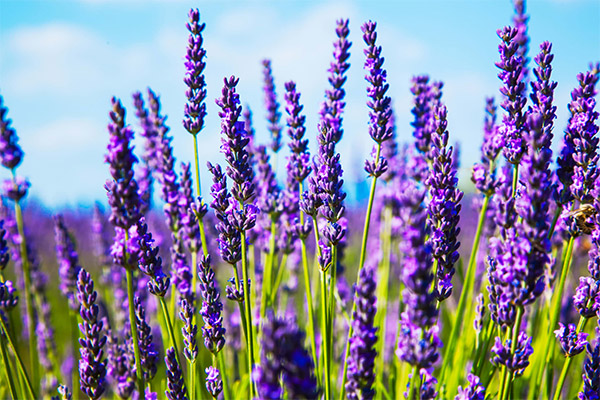
Lavender-based formulations have soothing, tonic, anti-inflammatory, antibacterial and analgesic properties. The plant is used to treat diseases of the digestive system, relieves headaches during migraines, tidies up high blood pressure, calms the nervous system, and relieves depression. Tea from lavender flowers does not matter any stress, it copes with insomnia remarkably, providing quick falling asleep and a quiet and undisturbed sleep.
Lavender oil relieves joint pain, it is used to heal burn wounds and relieve itching after an insect bite. A soothing massage with this tool is effective in the most complex and neglected cases, when you need to relax the muscles, relieve general stress and even calm the headache.
For women
For women, lavender can become a kind of friend, because with this plant stress, depression, nervous breakdowns are more easily tolerated. If you need to calm the nervous system, the first assistant is lavender.
Lavender oil can help in delicate women's problems: with cystitis, gynecological diseases. Lavender oil, due to its antiseptic properties, quickly copes with the inflammatory process and relieves pain. To solve a problem such as thrush, make douching with chamomile infusion with the addition of lavender essential oil.
In addition, lavender helps to normalize the menstrual cycle, eliminating hormonal disorders.
For men
In men - lovers of heavy fatty foods, alcohol and cigarettes, as a rule, high cholesterol in the blood, which is fraught with an early stroke or heart attack. Lavender preparations will help minimize these risks, they have a beneficial effect on the cardiovascular system, cleanse and heal the body.
In addition, lavender oil is a natural aphrodisiac, it helps in cases of decreased potency. And the ability to calm lavender not only normalizes the nervous system, removes irritability and aggression, but also gives self-confidence.
During pregnancy
Is it acceptable to use lavender during pregnancy? There are different opinions on this score.Some experts say that while waiting for a child, lavender is unacceptable. Others believe that the moderate use of its compounds poses no threat. But both those and the others agree on one thing: it is better not to take drugs with this plant inside. This is especially true in the first weeks of pregnancy, as lavender stimulates uterine contractions.
If you want to remove nausea with toxicosis, relieve irritability, restore normal sleep, you can resort to the external use of lavender, for example, take a bath. And it’s better not to buy the finished oil, but to prepare a homemade decoction of the dried flowers of the plant.
Ready-made oil can be used for massage if back pain in the last weeks of bearing a baby is burdened by dropping a couple of drops in massage oil. If you add the same pair of drops of lavender oil to olive, you can rub this mixture into the skin of the abdomen and massage your legs, which will have a preventive effect from stretch marks and varicose veins.
When breastfeeding
During breastfeeding, compositions with lavender are allowed only for external use. Nursing mothers can take massage sessions with the addition of lavender oil, they will help to lose weight and bring the body back to normal after childbirth.
Baths with the addition of lavender broths are also permissible to relieve stress, keep the nervous system in order. If during pregnancy, due to hormonal changes, the mother’s skin has suffered, baths and washing with lavender will restore their former attractiveness.
For kids
Pediatricians argue that the internal use of lavender for children under 12 years old is better to exclude. Later - it is possible, but first making sure that the child does not have allergies to it. It should be borne in mind that lavender oil is not recommended for boys who have entered puberty, since it can make adjustments to the formation of hormonal levels.
Lavender is good for children in the form of bathtubs, it will help relieve increased excitability, soothe and contribute to a quiet sleep. It alleviates the condition of babies suffering from diaper rash or dry skin. You can also use formulations with lavender for children in the form of inhalation to treat a runny nose and cough with a cold.
When losing weight
The property of lavender to fight obesity and to help lose weight is recognized. You can use it in the form of bathtubs, massage treatments and body wraps. In the bath you need to add a decoction, and for massage and body wraps use essential oil.
In addition, when dieting, it will be useful to eat 2-3 drops of lavender oil every day, adding them to honey or dairy products. Undiluted oil can not be taken orally - it can leave a burn on the mucous membranes.
Lavender in folk medicine
Traditional medicine has long appreciated the healing properties of lavender. Compositions created on the basis of lavender are taken orally and made of them compresses, lotions, inhalations, baths. For the preparation of medicinal products, both flowers and shredded greenery of the plant are used.

Inhalations from lavender are good as soon as a throat or cough starts. It is not necessary to wait until the malaise begins to aggravate, it is better to immediately drop 3 drops of oil in a glass of water, heat up to 50–55 degrees, and then, bending over the solution, cover your head with a large towel so that the product does not disperse idle and breathe this healing vapor 5-7 minutes.
Great benefits to the nervous system are baths with lavender oil. They are able to relieve stress, calm, cheer up, revive interest in life and put your skin in order, heal all wounds and cracks, rejuvenate, refresh. Just 5 drops of oil is enough for this. And with inflammation, itching and swelling at the site of insect bites, it is necessary to smear the skin several times a day with any composition based on lavender.
And often to solve one problem, traditional medicine offers several options for using lavender: for headaches and migraines, you can take a therapeutic bath with essential oil, drink warm tea from dried flowers, light an aroma lamp and heal, enjoying the lavender aroma.
Types of medicinal compounds with lavender
Infusion
- With increased fatigue. Pour a large spoonful of flowers with 2 glasses of freshly boiled water. Insist 2 hours, wrapped in a blanket. Trace and take the infusion. Daily allowance - four times a day for a quarter cup half an hour before meals.
- Cholagogue infusion. Heat 3 teaspoons of flowers and 400 ml of boiled water for 15 minutes in a water bath, while keeping the lid closed. Remove from the bath and insist 45 minutes. Drain and take this infusion half an hour before meals, 100 ml each.
- With tachycardia. 3 teaspoons of flowers pour 400 ml of boiled water and warm for 30 minutes in a water bath, stirring occasionally. Remove from the bath and insist 10 minutes. Drain the infusion, divide into equal portions and drink during the day in several doses.
- Bath from sweating feet. Lavender has the ability to regulate sweating, which is used if the legs sweat heavily, and, as a result, smell unpleasant. In such cases, useful baths are indicated. To make them, you first need to prepare an infusion: take 20 g of a dry mixture of lavender with sage and pour 0.5 l of boiling water into it. Insist and strain after 30 minutes. For greater effect, drip lavender (5 ml) and sage oil (3 ml) into this infusion. Pour the resulting composition into a basin with hot water and soak your feet for 20 minutes. The procedure is repeated several times every other day.
Tincture
Recipe for migraine: 3 teaspoons with a good slide of flowers pour 0.5 l of boiled water in a thermos. Insist hour. Strain, divide this norm into several parts and drink everything in a day.
Decoction
Decoctions of lavender can both be taken orally, and take a bath with them.
Therapeutic bath with broth
Pour 60 g of flowers in a saucepan of 1 liter of water, on a gentle fire, bring to a boil and remove from heat. After 10 minutes, strain. Pour the broth into a bathtub filled with water. In it, you can bathe a child if it is time to sleep, and he is very excited. This bath can also be taken by an adult in order to raise vitality or relieve any irritation on the skin.
Tea
If you drink lavender tea in the evening, it will calm your nerves and set you up for a good sleep. With a cold, it is better to drink it with a slice of lemon.
Tea for insomnia
A glass of boiling water pour 2 teaspoons with a slide of flowers. Insist, like regular tea, no longer than 10 minutes. In order for the drink to act, it is better to drink it an hour before going to bed.
Ointment
Ointments from lavender can be used to smear whiskey for migraines, to treat skin irritations, acne, burns. A medicinal plant is used in this form and to alleviate the symptoms of rheumatism.
Dry eczema ointment
Keep 0.5 liter of olive oil with two tablespoons of lavender flowers in a water bath for 2 hours. After insisting for about 10 hours. Such ointment is stored for a month and a half.
Syrup
Syrup from lavender is always suitable. If someone in the family wet their feet and catch a cold, someone has a sore throat, migraine flares up, their heart beats anxiously and more often than usual, there is no appetite - these problems are eliminated by taking 1 teaspoon of syrup 30 minutes before eating.
Lavender syrup
It’s easy to make syrup: boil for 20 minutes in 2 l of water and 2 kg of granulated sugar 100 g of lavender flowers. After 24 hours, the syrup is filtered and can be stored in a dark glass jar.
Lavender oil: properties and applications
Lavender essential oil is obtained from freshly harvested plants. The flowers contain the most oil, in the leaves and stems a little less, but they are quite suitable to get a healing agent from them.
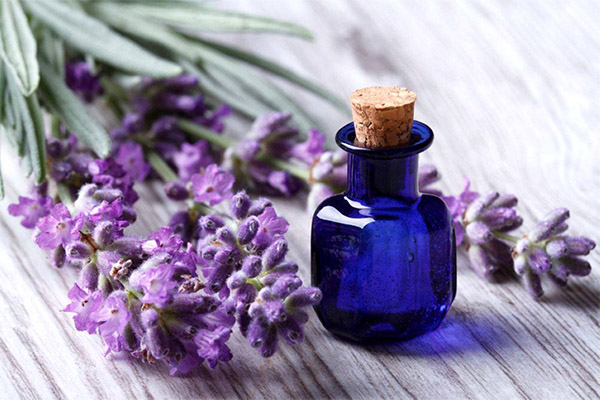
Plants are heated in a water bath, which breaks down their structure and turns the flower essence into steam. Vapors are collected and cooled, as a result of which they fall out in the form of condensate and essential oil flowing into one common container.It is not difficult to collect oil from the surface of the condensate. This process is called steam distillation.
Real lavender essential oil is colorless, sometimes it can be either yellow or light green. This product is afraid of the sun, so it is stored in a dark glass dish.
To check whether the oil is really natural, you can drop it on white paper. The natural product after evaporation should not leave a stain of fat. It is characterized by a sweet and tart aroma with a touch of bitterness. The finished product is rich in useful substances - limonene, aldehyde, tannins, linalyl acetate, coumarion, valerianic and butyric acids.
Lavender essential oil is appreciated for its wide range of actions, which allows its use both in medicine and cosmetology. It is able to fight bacteria and viruses, relieve spasms and cramps, anesthetize, have diuretic and soothing effects, improve heart activity and blood flow, including in the brain, and lower blood pressure.
Thanks to such a rich set of useful properties, therapists use it to treat ARVI, tonsillitis, pneumonia. With it, they increase immunity, stabilize the state of the nervous system, normalize sleep, accelerate the treatment of depression, and get rid of headaches. Effectively lavender oil to eliminate heart palpitations, with rheumatism, paralysis.
With the use of oil, wounds, burns and other skin lesions heal faster and without marks. With its help, the microcirculation of blood in the skin improves, its redness, itching and peeling are removed. Due to the ability to cleanse and rejuvenate the skin, oil has become the No. 1 remedy in cosmetology, including hair care. Oil is also used by gynecologists to treat female problems.
Application in cosmetology
Lavender can rightfully be given the first place among the herbs used in cosmetology, because, perhaps, it is able to cope with almost any problem in this area. The range of application of the plant in cosmetology is wide, since it has the ability to remove irritations and combat manifestations of an allergic nature. Thanks to its anti-inflammatory and antiseptic effects, lavender is successful in the treatment of acne, after which there are no traces left, the scars are smoothed. By regulating the production of sebum and the ability to narrow pores, it prevents the appearance of new acne.
In addition, lavender improves blood circulation and smoothes wrinkles. Lavender oil is used in wrap formulations using its anti-cellulite properties. It not only heals and nourishes the skin, but also strengthens hair and nails, and also successfully copes with the treatment of dandruff.
In cosmetology, decoctions and oil infusions from dried lavender raw materials and essential oil are used. Moreover, the essential oil itself is so concentrated that it can cause a burn, it can only be used as an additional component with other substances - oils, creams, etc. When preparing homemade cosmetics, remember that lavender is a kind of conductor that helps this essential creams and oils penetrate deeper into the skin, so they should be of impeccable quality. If the lavender oil is slightly warmed before use, this will enhance its healing effect.
For neck rejuvenation
A woman’s age is often read not so much on her face as on her neck and décolleté — this is where you can often see early wrinkles. Lavender oil is able to smooth and rejuvenate the skin. For this procedure, you need to mix 2 tablespoons of honey with 2 drops of essential oil and apply this composition for half an hour on the upper chest and neck.
For firm skin
The fight against cellulite sometimes turns for women into a long and inconclusive. Lavender not only successfully copes with the problem, it also tightens the contours of the body, has a rejuvenating effect and prevents the appearance of stretch marks. For this, lavender is added to the oil used for regular massage: 5 drops per 10 ml of massage.In combination with lavender baths, this procedure works especially efficiently.
For strong nails
In order for the nails to stop exfoliating, become strong, you need to rub a drop of lavender oil daily on each nail plate for a minute. Thus, the cuticle will become softer, and the nails will have a healthy shine.
For gentle hands and healthy nails
Dissolve a spoonful of sea salt in 250 ml of water, drop 10 drops of lavender oil into it and use this composition as a bath for hands. After 15 minutes, remove your hands, dry with a towel and apply cream.
For facial skin
Put 2 drops of lavender oil in a bowl with 2 tablespoons of olive oil. Stir and apply on face. After 20 minutes, rinse with clean, warm water.
Wrinkle Facial Mask
Heat a spoon of honey in a water bath, remove from the stove, add beaten egg white, 50 g of yogurt, 3 drops of lavender oil to it, mix. Apply a mask on the face for 15-20 minutes. Then wash with a little warm water.
Acne mask
Beat the egg yolk, add a couple of drops of essential oil, mix. Spread the mixture on the face and lie down calmly for 15–20 minutes. Then rinse with clean water.
For dandruff
At that amount of shampoo, which is enough for ordinary shampooing, drip 3-4 drops of lavender oil. Then proceed as usual.
Hair Growth Mask
To hair grow well, and dandruff no longer torment, mix 3 drops of lavender and 2 tablespoons of burdock oil, spread the mixture over all hair and rub into the scalp. For 40-50 minutes, wrap your head with polyethylene and, for heat, with a bath towel. This mask is well washed off with shampoo.
Lotion
Shake 100 ml of glycerin, 150 ml of water, 100 ml of good vodka and 10 drops of lavender oil in one bowl. Apply to wipe the skin in the morning and evening.
Lavender in cooking
If you look at lavender only as a medicine, perfume or cosmetic, this will not be entirely correct. For Russian cuisine, she is a beautiful, but so far unfamiliar lady. And in the arsenal of French, Spanish and Italian housewives there are many culinary recipes in which this plant is used. In the Mediterranean countries, dry lavender flowers are ground into powder and sprinkled with it ready-made dishes, like pepper. In Hungary, even make ice cream with lavender.
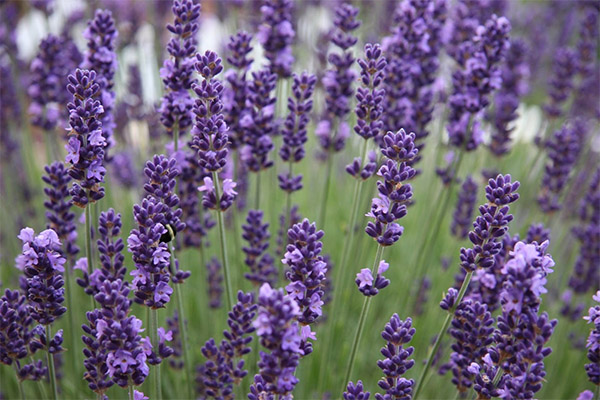
You can add a plant even in sauce, even in soup, even in dessert, season it with meat and salad - everywhere the aroma of lavender comes in handy. The meat, pickled with the addition of lavender and rosemary, has become one of the most commonly used European dishes. A culinary composition of honey and lavender is already considered a classic of haute cuisine, in such a community they are used in cakes, baked cookies and bread with it, jellies and jams are boiled, and added to cottage cheese. But you need to use lavender very carefully, in small quantities, otherwise the aroma will ruin the whole dish.
Lavender sugar
Put 3-4 lavender flowers in the sugar bowl, and in a day lavender sugar will be ready. It will acquire an interesting smell and help bring variety to the evening tea party.
Lavender vinegar
5-6 flowers of dry lavender toss in a half-liter bottle of vinegar. Insist a week. Vinegar absorbs lavender aroma and will be a spicy addition for salad or sauce.
Lavender lemonade
To get 1 liter of lemonade, just 1 teaspoon of dried lavender is enough. Pour it with a glass of boiling water, stir with 5 tablespoons of granulated sugar and strain when it cools. Squeeze the juice from the lemon there. Cut the second lemon into small pieces. Pour crushed ice into a beautiful jug, put chopped lemon, pour lavender broth. Add 750 ml of sparkling water.
Lavender Chicken
For the marinade, you need to take 1 tablespoon of rosemary, thyme, half lemon juice, 2 tablespoons of olive oil and honey, 1 teaspoon of salt and half a teaspoon of lavender flowers. Pickle 1 kg of chicken fillet for a couple of hours, then send it to the grill.
The use of lavender in everyday life
Due to its pleasant smell, lavender essential oil is widely used in everyday life. Our grandmothers also kept a small bag with dry lavender in the corner of the chest of drawers, this tradition has survived to this day.Such a sachet impregnates with a floral aroma everything that is stored on the shelves. It is especially nice to sleep on such bedding. The second task that can be solved in this way is to drive the mole out of the cabinet.
In addition, today the disinfecting property of lavender oil is used in everyday life, for which it is often added to the washing machine during washing. In order to aromatize and disinfect the air, put a cotton pad moistened with oil in a vacuum cleaner bag.
Wipe off the fridge or kitchen cabinets from unpleasant odors will help wiping them with a sponge, which dripped essential oil.
If you light an aroma lamp with lavender at home, you can not only fill the house with a pleasant smell, but also get rid of mosquitoes and flies. And if you put a dry winter lavender bouquet in a vase, a light aroma in the house will be provided for a long time.
How to grow lavender at home
Many would like to transfer to their windowsill a small piece of the Mediterranean - at least in the form of lavender. For many years it was believed that at home its existence is impossible, but empirically, passionate plant lovers figured out the secrets of growing it in an apartment. The main thing is careful temperature control and the fulfillment of all the "whims" of the beauty.
The pot for planting lavender should be taken at least two-liter, its diameter should be 30 cm. Drainage should be laid on the bottom, expanded clay, small pebbles or nutshells can be used, and loose sandy alkaline soil should be prepared.
Window sills are suitable for the plant, where there is enough bright sunlight, otherwise it will die. Frequent watering for lavender is fatal, it is enough to water once a week, and in the autumn rainy season, when the air has a high moisture content, once every 10 days. For the winter, lavender is cut a little and put in a cool (but not cold!) Place, watering is reduced to once every 2 weeks.
In order for lavender to please the owner for a long time, it needs regular top dressing, you can use those fertilizers that are usually used for indoor plants.
When the root of the plant reaches the day of the pot, you need to transplant it immediately so that it does not get sick. A pot is selected with a larger diameter, and then they act according to the usual rules for transshipment of plants. By the way, lovers of lavender note that in light pots it grows better than in dark ones, since dark ones attract sunlight more strongly, and the soil overheats, and this harms the roots.
What is lavender honey good for?
There are two types of honey called lavender. The first is natural, collected by bees from lavender plantations. It is rare, not cheap, and its traditional medicine rates very highly. The second is mixed with lavender and heated regular honey. It is similar to natural only in smell, it has no healing lavender qualities.

Natural lavender honey is unusually beautiful. A fresh, recently harvested product literally sparkles and shimmers like a melted gold bar carrying a lavender scent. It tastes sweet, but not cloying. Honey does not crystallize until three months, but when this happens, it acquires a white color and becomes like a cream.
Lavender honey alone can be a sedative. The fact is that it contains a large amount of an amino acid called tyrosine, which has a beneficial effect on the brain. In medicine, this feature is used to treat pathologies of the nervous system - stress, depression, Alzheimer's or Parkinson's disease. It helps to cope with chronic fatigue syndrome.
In addition, honey well supports the body, weakened by a serious illness or operation, helps a person to quickly recover strength after complex mental work. Despite the fact that this is a sweet product, it lowers blood glucose and also reduces cholesterol.
Honey took all its best properties from lavender, as a result of which it is useful to use it to improve memory and stimulate brain activity, as well as for weight loss, since it accelerates the metabolic processes in the body, to cleanse toxins and toxins. Honey helps to heal wounds, scratches and burns in the mouth, kills viruses and other pathogenic organisms, and also has a beneficial effect on digestion and the functioning of the heart and blood vessels.
Contraindications
As a rule, neither dry lavender nor lavender oil causes obvious allergic reactions, but nevertheless, cases of its individual intolerance are possible. In such cases, the plant is contraindicated in any form.
You can not use lavender inside pregnant women, nursing mothers and children under 12 years old.
Lavender has good choleretic properties, and this can harm people suffering from diseases of the gallbladder associated with impaired motility and the presence of stones. If the acidity of the gastric juice is increased, the use of the plant inside should also be abandoned, since it can cause heartburn. Since lavender has the ability to lower blood pressure, hypotonics cannot be used. You will also have to abandon lavender, if the doctor has prescribed drugs containing iodine.
If you follow these recommendations and do not exceed the prescribed dosage when using it, the plant will only benefit. Exceeding the limits may cause side effects such as weakness, nausea, palpitations, dizziness, sweating, chills, and even cramping.
«Important: all information on the site is provided exclusively in fact-finding purposes. Before applying any recommendations, consult with a profile specialist. Neither the editors nor the authors are liable for any possible harm caused materials. "

